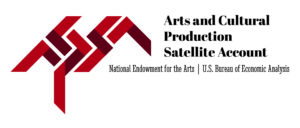March 15, 2022
 Updated Creative Economy State Profiles are now available, with information that describes the value of arts and cultural production in every state during the pandemic in 2020. These data, published by the U.S. Bureau of Economic Analysis (BEA) in partnership with the National Endowment for the Arts (NEA), provide an important baseline for the value of the creative economy. They track the annual economic impact of arts and cultural production from 35 industries, commercial and nonprofit, for the nation and every state.
Updated Creative Economy State Profiles are now available, with information that describes the value of arts and cultural production in every state during the pandemic in 2020. These data, published by the U.S. Bureau of Economic Analysis (BEA) in partnership with the National Endowment for the Arts (NEA), provide an important baseline for the value of the creative economy. They track the annual economic impact of arts and cultural production from 35 industries, commercial and nonprofit, for the nation and every state.
In 2020, arts and cultural production accounted for:
This year’s data offers additional information about the acutely negative impact of the coronavirus pandemic on the creative sector, while affirming the significant contributions of the arts to the nation’s economy. Using inflation-adjusted numbers, the U.S. arts economy shrank at nearly twice the rate of the economy as a whole: arts and cultural production fell 6.4%, compared with a 3.4% decline in the overall economy.
Certain industries within the arts and cultural sector were hit especially hard. For example, performing arts presenters and performing arts companies joined oil drilling/exploration and air transportation as the steepest-declining areas of the U.S. economy in 2020.
Many of the organizations, programs and activities that state arts agencies support bring communities together to engage and participate in the arts. Those that could no longer engage with people in 2020 were greatly affected, and state arts agencies were integral to providing and administering relief funding efforts to sustain artists, organizations and communities.
This year’s data reasserts that the arts and culture sector is a large and vital portion of the U.S. economy—contributing $877 billion to GDP and 4.6 million jobs—and that the resurgence of the creative economy is necessary for the resurgence of the American economy. Research confirms that the arts can improve—not merely reflect—the health of the broader economy. Furthermore, this same research shows that the arts offer economic diversification and can help economies rapidly recover from economic downturns.
NASAA’s Creative Economy State Profiles help to make data from the BEA’s Arts and Cultural Production Satellite Account (ACPSA) more accessible and engaging. Produced in cooperation with the National Endowment for the Arts, this interactive dashboard provides information in a visual format to describe the creative economy in every state.
Your state’s creative economy story is unique, and this tool allows you to explore and share that story with key decision makers. Use the Creative Economy State Profiles to understand:
Designed to complement the NEA’s suite of ACPSA resources, this interactive dashboard is one of many tools to help state arts agencies and arts advocates understand and communicate federal data about your state’s creative economy. As you are using the information, remember that federal ACPSA data includes commercial arts enterprises but not self-employed workers. NASAA recognizes that many states are collecting additional local data that measure the effects of the pandemic on independent artists and nonprofit arts organizations.
Please view and explore the Creative Economy State Profiles, and don’t hesitate to contact me for help using this information in your state.
Best regards,
